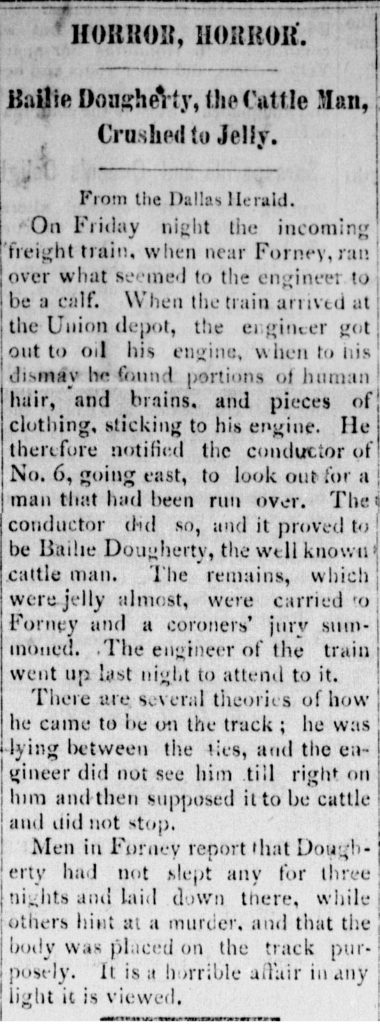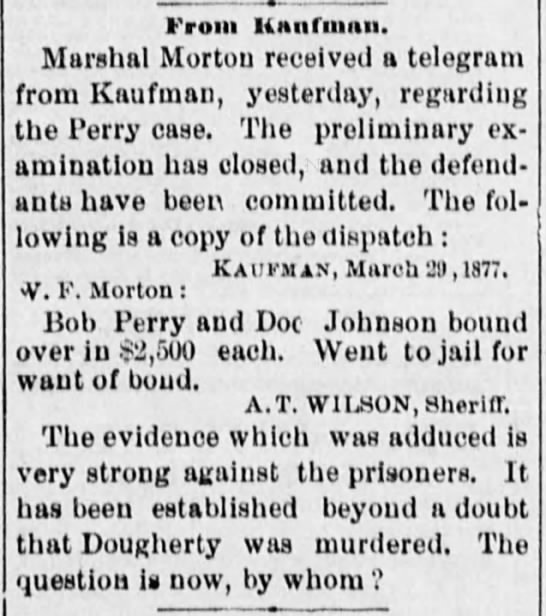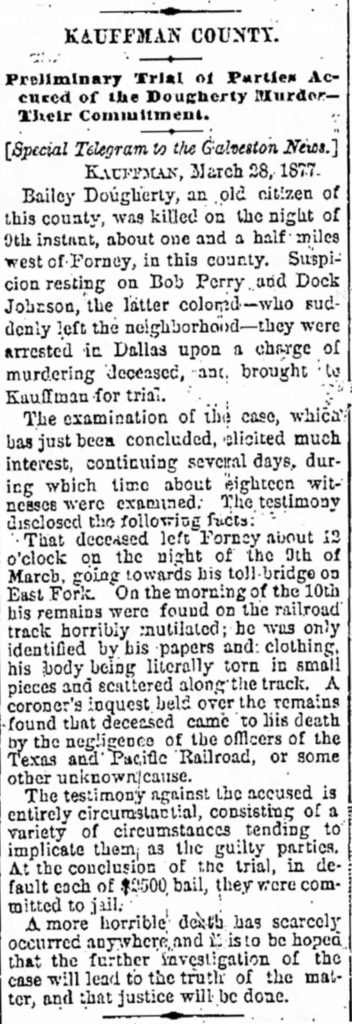Murder of Bailey Daugherty
WARNING: Some of the details in this article are very graphic.

The following articles and excerpts from Forney Country: A History of Northwestern Kaufman County, Texas by Jerry Flook, describe in graphic detail the murder and cover-up that occurred in 1877.
Bailey Daugherty moved to Kaufman County with his family in the 1850’s. With a purchase of several hundred acres, Bailey immediately started purchasing cattle and soon became a successful cattleman. With his brother Louis and cousin John Daugherty, Bailey had his hand in many other money-making ventures, including a toll bridge and real estate. He was one of the wealthiest men in all of Texas.
Bailey married Jane Wideman and together they had three children. It was the tragic death of Jane that lead to some major changes in Bailey’s life and fortune. Bankruptcy followed, and later, his bizarre death.
In the 1870’s, Bailey and his son-in-law John West opened the first saloon in what was then called Brooklyn. The operation involved gambling and although he was charged several times, there’s no record of any convictions. There were even reports that the saloon watered down its whiskey. Bailey’s lifestyle – gambling, drinking, and loose women – took a toll on his pocketbook.
On March 9, 1877, Bailey Daugherty was murdered and left on the train tracks. What looked like a tragic accident was actually a cover-up for murder. The following paragraphs are taken from the book Forney Country.
——
By the Friday, March 16, issue of the [Dallas] Herald the circumstances of Daugherty’s death were becoming clearer. An inquest had been held at Forney and had determined that Daugherty had almost certainly been the victim of “foul play.” An individual of dubious character, one Bob Perry, had been seen in Dallas sporting a silver pocket watch recognized to be the one worn by Bailey Daugherty. Perry was arrested near his mother’s home in East Dallas, where he was working on a house.

The Herald reporter, immediately on hearing the news of the arrest, headed to the Dallas jail to interview the prisoner. On his way he met Bony (Napoleon Bonaparte) McIntire of the Forney area, who had been one of the group who had gathered up Daugherty’s remains. McIntire ported that Perry and the victim had both been at a dance in Forney the night before. He also said that sometime during the evening, Daugherty had gotten into a squabble with his partner and son-in-law John West. McIntire also reported the rumor that Daugherty had recently left $200 with Perry’s new wife, the former Mina Weeks. According to McIntire, Perry had left Forney immediately after Daugherty’s body was found. The reporter in his article did not speculate on the significance of any of these observations.
The reporter was then taken to Perry’s cell to interview him. Perry was about 19 years old, small of stature and had red hair and freckles. He protested his innocence, saying that Daugherty had been his best friend and always let him have money when he asked. He insisted that Daugherty had not left any money with his wife, pointing out that Daugherty and West and had witnessed the argument between them. He admitted to having Daugherty’s watch but insisted that Daugherty had given it to him the evening of his death.

Also jailed in Dallas was a Negro, Doc Johnson. According to Johnson, he had gone from Dallas to Forney with Perry on the Tuesday before the murder to cut wood in the bottoms. But on the morning of the day of the murder he had returned to Dallas, telling Perry that he feared there was trouble brewing and that ‘there was going to be a fuss.’ He told the reporter that Daugherty often visited Perry’s house in his absence and that Perry’s wife was very familiar with him. Johnson further recounted that on the Monday after Daugherty’s death Perry told him to go to Forney and get his (Perry’s) things from his house (about 2 1/2 miles from Forney). When Johnson reached Perry’s place he was accosted by a number of armed men, who held a gun to his head and asked Perry’s whereabouts. He told them he didn’t know. As Johnson and these men rode back toward Dallas, they were joined by Perry. When they reached the vicinity of White Rock Creek, three shots were fired at Perry, who apparently escaped unharmed. Doc Johnson implied that he had much more to tell but was keeping quiet until the trial.
On Friday, March 16, one week after the murder, A.T. Wilson, Kaufman County sheriff, transferred Perry and Johnson to the Kaufman jail, where each was placed under $2,500 bond. Neither could make bond. Almost immediately a rumor reached Dallas that Doc Johnson had been lynched at Kaufman, but the rumor proved false.
Less than a week later the Dallas marshal, at the urging of Daugherty’s son, obtained warrants to search the house of Perry’s mother for the murder weapon, which had been described to the authorities by Doc Johnson. A self-cocking, six-chamber revolver fitting the description was found and showed evidence of four of the chambers having been recently fired but reloaded. As a result of this discovery Mrs. Perry was also arrested and transferred to the Kaufman jail.
Perry was indicted for the murder of Bailey Daugherty. The charges against his mother and Doc Johnson were evidently dropped. The case was finally tried in November of 1877 and although the Dallas Herald predicted a conviction based on what it felt was a strong case, the Kaufman jury apparently did not agree, acquitting Bob Perry due to the circumstantial nature of the evidence against him.
Bailey Daugherty’s remains are buried at Old Union Hill in the Daugherty Cemetery. Interestingly enough, also interred there are Dan Valentine, and probably William Nahan, both murder victims. If Forney has a “Boot Hill,” Daugherty Cemetery would be it.
